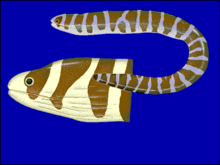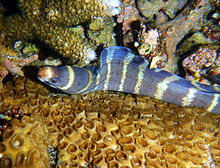

| Barred moray | |
|---|---|

| |
| Scientific classification | |
| Domain: | Eukaryota |
| Kingdom: | Animalia |
| Phylum: | Chordata |
| Class: | Actinopterygii |
| Order: | Anguilliformes |
| Family: | Muraenidae |
| Genus: | Echidna |
| Species: |
E. polyzona
|
| Binomial name | |
| Echidna polyzona (J. Richardson, 1845) | |
| Synonyms[2] | |
| |
The barred moray (Echidna polyzona), also known as the banded moray, the dark-banded eel, the girdled moray, the girdled reef eel, the many banded moray eel, the ringed moray, the ringed reef moray, the striped moray and the zebra eel,[3]) is a moray eel of the family Muraenidae.[4] It was described by John Richardson in 1845, originally under the genus Muraena. It is a marine, tropical eel which is known from the Indo-Pacific, including the Red Sea, East Africa, the Hawaiian Islands, the Marquesan Islands, the Tuamotus Islands, the Ryukyu Islands, and the Great Barrier Reef. It dwells at a depth range of 2 to 20 metres (6.6 to 65.6 ft), and leads a benthic lifestyle in reefs and shallow lagoons. Males can reach a maximum total length of 72.3 centimetres (28.5 in).[4]
The barred moray's diet consists of shrimp such as Saron marmoratus, crabs, isopods, and polychaetes,[5][6] which it feeds on during both day and night. It is of commercial interest to both subsistence fisheries and the aquarium trade.[4]

| Echidna polyzona |
|
|---|---|
This Muraenidae article is a stub. You can help Wikipedia by expanding it. |